Wild salmon steaks flash-cooked in flavourful Mediterranean-style marinade. Served hot or cold.
Recipe Story
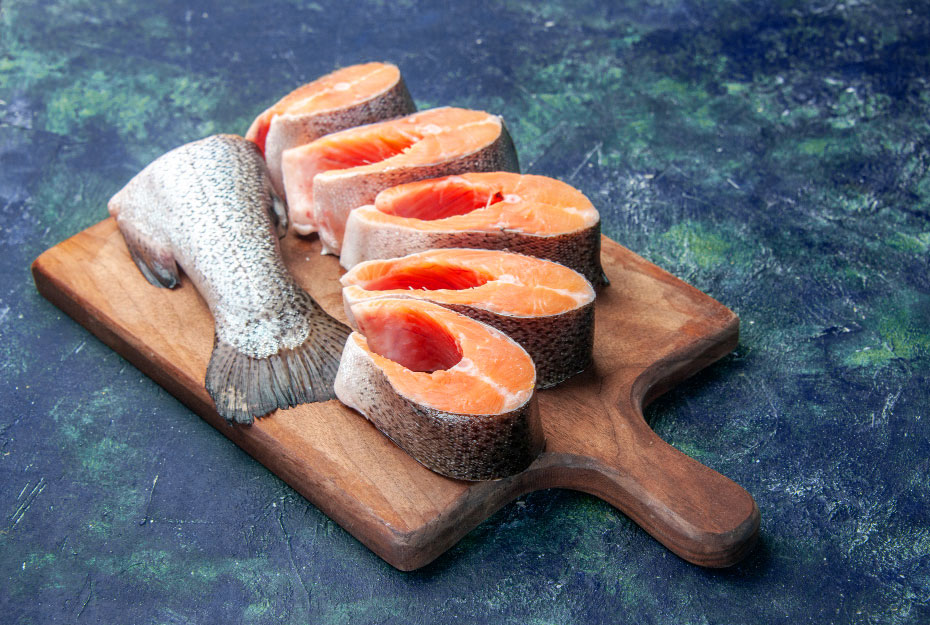
Salmon is my favourite fish, and I usually prepare it by grilling and frying. But recently, I wanted to try something different, so I experimented with a slightly unusual recipe. It works with other types of fish as well so give it a try!
This unique salmon recipe draws inspiration from traditional methods of marinating and cooking fish or meat. It is also influenced by coastal cuisines, particularly in Croatia and Italy, where fish is often stewed with the addition of vinegar, as seen in dishes like Croatian Brodet or Italian Fish Soup.
The twist here is to make the most of the marinade liquid full of goodness. Instead of discarding it, which is a common practice, why not use the marinade in the cooking process? This approach aims to preserve and enhance the rich flavours of the marinade, which often contains a blend of spices, herbs, and, notably, vinegar.
Cooking the salmon in the marinade allows the fish to absorb and infuse these vibrant flavours, resulting in a salmon that’s incredibly succulent, moist, and flavourful.
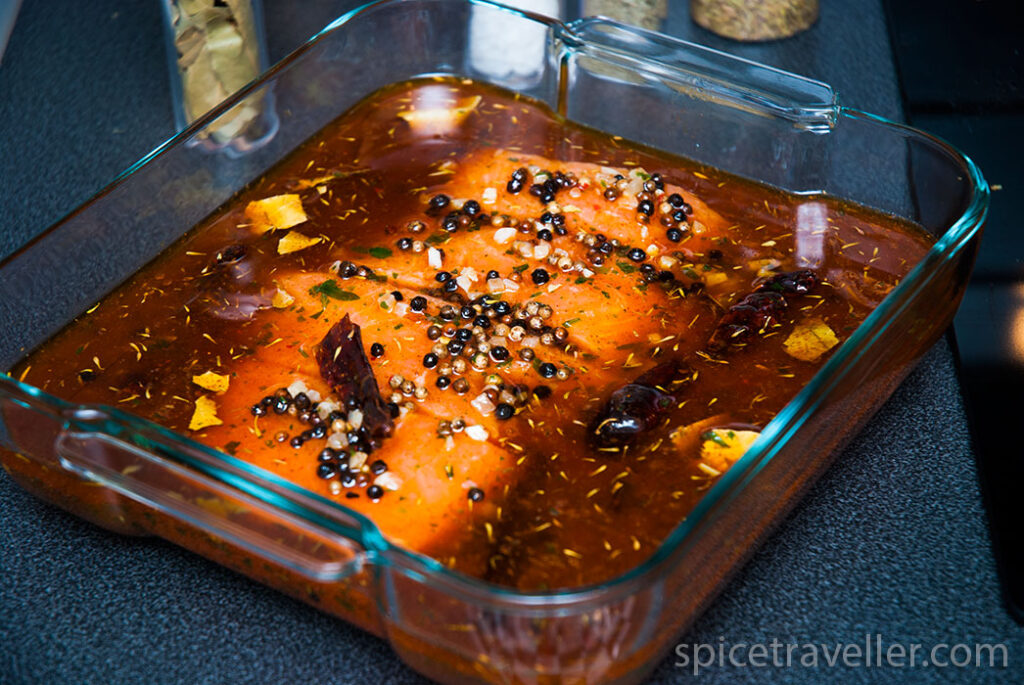
Essential Ingredients
- salmon – When picking salmon, go for wild-caught if you can. Wild salmon, raised in their natural habitats, enjoy a diverse diet and active lifestyle. This results in a richer, more robust flavour and a higher content of heart-healthy omega-3 fatty acids. It’s also a choice that aligns with sustainability and supports the preservation of natural ecosystems
- vinegar – Vinegar is the key player in this recipe, bringing that essential tangy taste to the forefront. The marinade is all about infusing the dish with its unique character, and vinegar is at the heart of it. Apple cider vinegar is often the top choice, known for its milder and slightly sweeter notes. However, it’s a versatile recipe, and if you prefer a stronger tang, you can opt for white or red wine vinegar. They each offer a bolder flavour profile. Additionally, balsamic vinegar works wonderfully as a sweeter alternative.
Flavour boosters
- garlic – Garlic adds its unique aromatic richness. It’s a crucial flavour booster element that shouldn’t be omitted, as it plays a significant role in elevating the taste. A little garlic goes a long way. To get the best results, it’s advisable to stick to the recipe’s recommended amount, ensuring the perfect balance of flavours.
- paprika – Paprika is a great addition to this dish. It’s a sweet, powdered spice that brings not only a burst of vibrant colour but also a mild, peppery taste. If you want to experiment, you can also go for smoked paprika to infuse smokiness into the dish, or try hot paprika if you’re craving a bit of spicy excitement.
- herbs: bay leaf, thyme, parsley – The inclusion of bay leaf and thyme in this recipe is a nod to Mediterranean cuisine, imparting an aromatic and earthy quality that elevates the overall character of the dish. Don’t hesitate to be generous with the herbs – there’s no such thing as too much.
- white wine – When it comes to choosing the right wine for this dish, Sauvignon Blanc and Chardonnay are the top contenders. They lean towards the citrusy side, introducing a delightful acidity that beautifully complements the salmon’s richness. But, feel free to explore and experiment with your wine choices. If you prefer a hint of sweetness, you can opt for a sweeter white wine like Riesling or Moscato. These wines saturate the salmon with a gentle sweetness, creating an intriguing contrast with the other ingredients.
Cooking & Tips
For the finest salmon, Waitrose is a reliable choice, offering quality salmon fillets. I usually leave the skin on but feel free to remove it if that’s your preference. You can also explore other salmon cuts such as steaks or large chunks of fish.
I served two salmon steaks per person since we had lighter sides like spinach and salad. However, if you opt for heartier sides such as potatoes or pasta, one 110g salmon steak (the ones I got from Waitrose) is perfectly sufficient per person. It’s all about matching the meal to your preferences and ensuring a satisfying dining experience.
This dish can be cooked in the oven or on the stovetop. The recipe is for the oven method, but in case you prefer to prepare it on the stove, here are the simple instructions;
Use a large, wide, and shallow pot or a deep frying pan for the stovetop approach. Place the salmon pieces skin side down, and then pour the marinade over them. Add enough olive oil to cover the fish. Heat the pot over high heat until it reaches a gentle boil, then turn off the heat and cover the pot to let it cool slightly.
I added a spicy kick to my salmon by including whole dried chillies in the mix for a burst of heat and flavour.
Ingredient Substitutions
- Salmon – While salmon is the star of this dish, you can substitute it with other oily fish like trout, mackerel, or even sardines. These alternatives offer a similar richness and can complement the marinade flavours effectively.
- Vinegar – If you don’t have apple cider vinegar on hand, you can use white wine vinegar, red wine vinegar, or even balsamic vinegar for a slightly different but equally delightful tang. When using balsamic vinegar, i would suggest mixing with water 50:50.
- Herbs and Spices – Instead of bay leaves and thyme, dill is a perfect herb choice, especially if you want to enhance the dish’s compatibility with salmon. Bay leaf and thyme were chosen for a Mediterranean-style influence, but dill complements salmon wonderfully with its fresh and aromatic profile, making it an excellent alternative. Different herbs can bring out varying aromatic notes, allowing you to tailor the dish to your taste.
- Wine and Alcohol – Consider dry white wines like Chardonnay or Sauvignon Blanc. For a deeper, richer taste, consider experimenting with red wine. Varieties such as Cabernet Sauvignon or Merlot can add a robust and velvety undertone to the marinade, enhancing the overall flavour profile of the dish
For an alcohol-free version, replace the wine with a grape juice or vegetable broth. But rest assured that the alcohol used in the recipe evaporates during cooking, leaving behind the rich flavours without the alcohol content.
Presentation & Serving
If you intend to enjoy this salmon cooked in marinade the same day, plate the dish while it’s still warm. However, if you’re planning to serve it as a refreshing cold starter, let the salmon stays in the marinade, in the fridge for 1-2 days.
When served cold, salmon canapés are an excellent choice for upcoming parties, gatherings with friends, or an elegant dinner at home with your loved one.
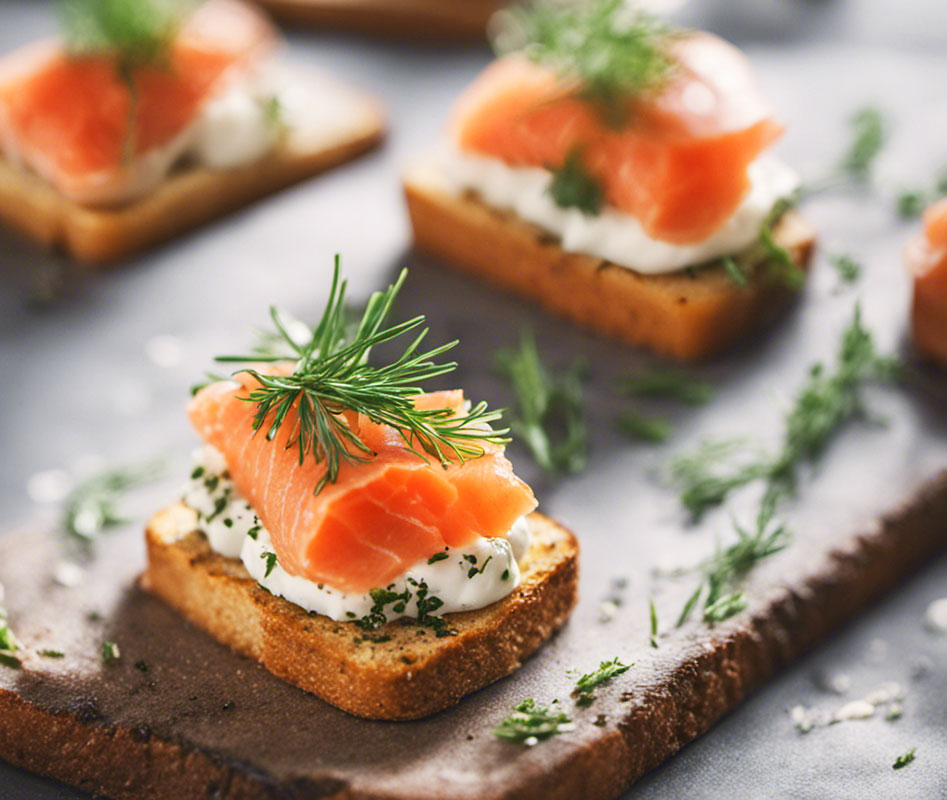
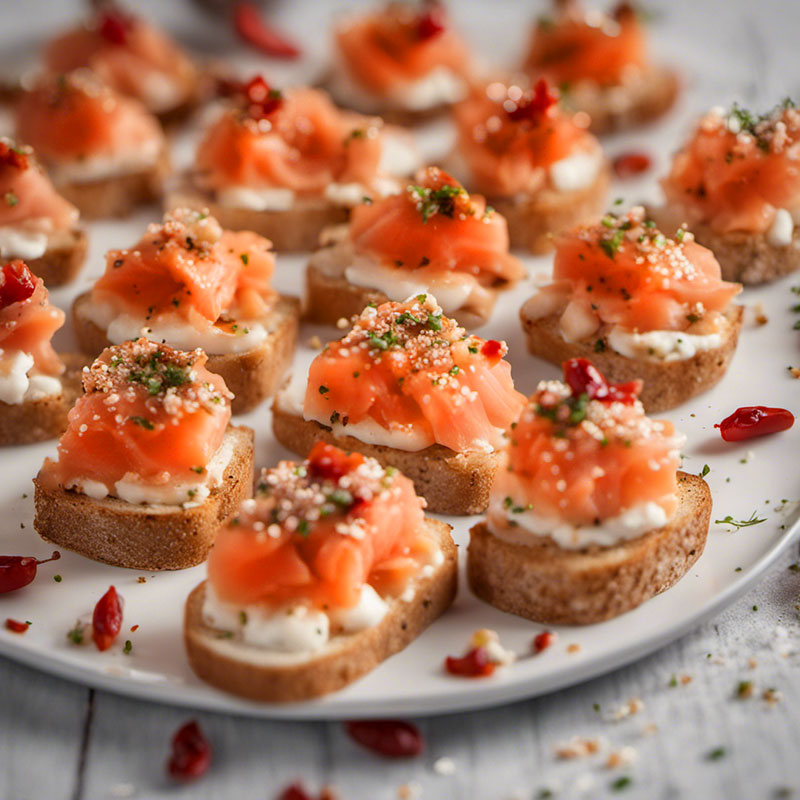
I served it on the same day, accompanied by Mediterranean salad and a side of spicy sautéed spinach. Bon appétit!

Recipe Card
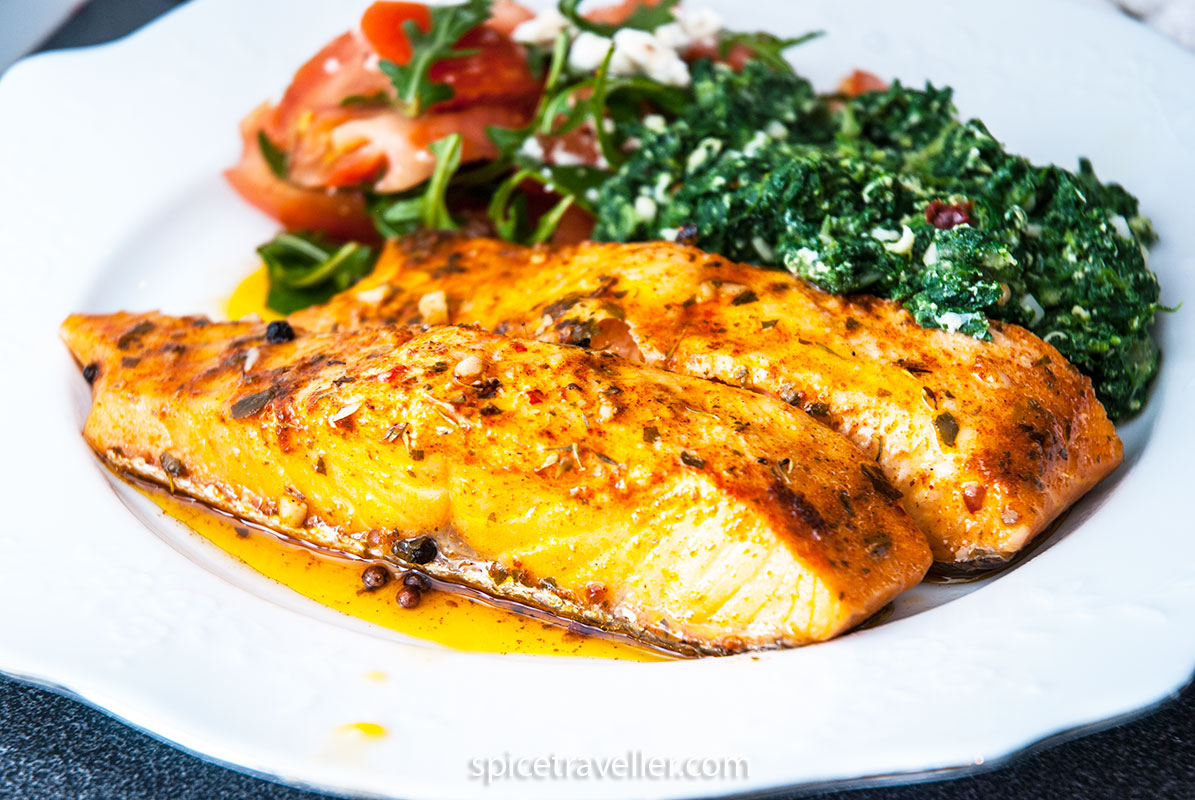
Salmon cooked in Mediterranean-style marinade
Ingredients
- 450 g wild salmon
Marinade
- 3 cloves garlic
- 4 bay leaves
- 1 tbsp paprika
- 1 tbsp dried thyme
- 1 tbsp chopped parsley
- 100 ml white wine
- 200 ml apple cider vinegar
- 2 tsp black pepper - mix of whole and cracked
- 1 tsp salt
- olive oil - as needed, to cover fish
Optional
- 1 tsp chilli flakes or whole chillies
- 2 tbsp dill - ( instead of bay leaf and thyme)
Instructions
- In a bowl, mix all of the marinade ingredients except olive oil
- Cut the salmon into small pieces, as desired. Place them in an oven dish with a lid. Pour over the marinade and then add enough oil to cover the fish.
![]()
- Preheat the oven to 170 C. Put the prepared salmon in the preheated oven and bake for 5 minutes. Or until the liquid starts to bubble up. Then turn off the oven and leave it to rest for 15 – 20 minutes before serving.
![]()
- Serve it with your favourite side dish.


